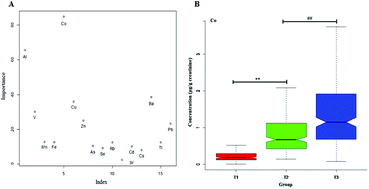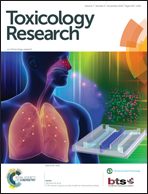Urinary metabolomics reveals novel interactions between metal exposure and amino acid metabolic stress during pregnancy†
Abstract
Pregnant women are a unique group undergoing profound structural modifications in uterus, breast, adipose tissue and extracellular fluids. Amino acid metabolic stress is a unique physical process that occurs during pregnancy. Metals constitute a fundamental part of the maternal body and have a universal effect on amino acid metabolism. However, the exact interaction between metals and amino acid metabolism during pregnancy is unknown. The aim of the present study was to determine the correlations of metals with amino acid metabolic intermediates in the urine of 232 healthy pregnant women in their first, second and third trimesters during normal pregnancy. Sixteen metals in the urine of 232 healthy pregnant women in their first, second and third trimesters were quantified using inductively coupled plasma mass spectrometry (ICP-MS). An ultra-performance liquid chromatography quadrupole time-of-flight mass spectrometer (UPLC-QTOFMS)-based metabolomics approach was conducted to detect intermediate products involved in amino acid metabolism during the entire pregnancy period. A panel regression model was established to investigate the relationship between urine metals and amino acid metabolism. Seven metals—cadmium, cobalt, copper, cesium, manganese, thallium and vanadium—showed significant association with amino acid metabolic intermediates, including 2-oxoarginine, 3-indoleacetonitrile, indole, indole-5,6-quinone, N2-succinyl-L-glutamic acid 5-semialdehyde, N-methyltryptamine and N-succinyl-L,L-2,6-diaminopimelate, in the healthy pregnant women. These findings indicated that exposure to cadmium, cobalt, copper, cesium, manganese, thallium and vanadium significantly affected the metabolic status of tryptophan, arginine, proline, tyrosine and lysine metabolism in the maternal body during normal pregnancy.



 Please wait while we load your content...
Please wait while we load your content...